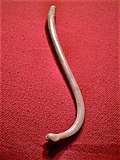Baculum
Baculum
The baculum (also known as the os penis, or penile bone) is a bone found in the penis of many placental mammals. It is absent in the human penis, but present in the penises of other primates, such as the gorilla and chimpanzee. The baculum is used to assist in sexual reproduction by maintaining sufficient stiffness during sexual penetration. The presence, size, and shape of the baculum can vary greatly among species, and its evolutionary purpose is a subject of ongoing research and debate among scientists.
Function
The primary function of the baculum is to provide structural support to the penis during copulation, ensuring that it remains rigid enough to achieve successful penetration and insemination of the female. This is particularly important for species in which the duration of copulation is long, or where the male must mate with multiple females in a short period. The baculum may also play a role in stimulating the female's reproductive tract, which could be advantageous for sperm competition.
Evolution
The evolutionary origins of the baculum are not well understood. It is believed to have evolved independently in various mammalian lineages, suggesting that it confers significant reproductive advantages. The size and shape of the baculum are highly variable, not only between different species but sometimes also within a species. This variability is thought to be the result of sexual selection, with females possibly preferring mates with certain baculum characteristics that indicate better physical condition or genetic quality.
Variability
Among mammals, the size of the baculum can range from a few millimeters to several centimeters. For example, the baculum in certain species of bats is relatively small, while in some species of walruses, it can reach lengths of over 60 cm. The shape of the baculum is also highly variable, with some being straight and others having complex curves, hooks, or flanges. These differences are often related to mating practices and the anatomy of the female reproductive tract.
Research and Significance
Research on the baculum continues to provide insights into the reproductive strategies of mammals and the evolutionary pressures that shape sexual organs. Studies have examined the relationship between baculum morphology and mating systems, sperm competition, and even climate adaptation. Understanding the function and evolution of the baculum can also contribute to broader discussions on sexual selection and reproductive success in mammals.
See Also
Baculum
Transform your life with W8MD's budget GLP-1 injections from $125.
W8MD offers a medical weight loss program to lose weight in Philadelphia. Our physician-supervised medical weight loss provides:
- Most insurances accepted or discounted self-pay rates. We will obtain insurance prior authorizations if needed.
- Generic GLP1 weight loss injections from $125 for the starting dose.
- Also offer prescription weight loss medications including Phentermine, Qsymia, Diethylpropion, Contrave etc.
NYC weight loss doctor appointments
Start your NYC weight loss journey today at our NYC medical weight loss and Philadelphia medical weight loss clinics.
- Call 718-946-5500 to lose weight in NYC or for medical weight loss in Philadelphia 215-676-2334.
- Tags:NYC medical weight loss, Philadelphia lose weight Zepbound NYC, Budget GLP1 weight loss injections, Wegovy Philadelphia, Wegovy NYC, Philadelphia medical weight loss, Brookly weight loss and Wegovy NYC
|
WikiMD's Wellness Encyclopedia |
| Let Food Be Thy Medicine Medicine Thy Food - Hippocrates |
Medical Disclaimer: WikiMD is not a substitute for professional medical advice. The information on WikiMD is provided as an information resource only, may be incorrect, outdated or misleading, and is not to be used or relied on for any diagnostic or treatment purposes. Please consult your health care provider before making any healthcare decisions or for guidance about a specific medical condition. WikiMD expressly disclaims responsibility, and shall have no liability, for any damages, loss, injury, or liability whatsoever suffered as a result of your reliance on the information contained in this site. By visiting this site you agree to the foregoing terms and conditions, which may from time to time be changed or supplemented by WikiMD. If you do not agree to the foregoing terms and conditions, you should not enter or use this site. See full disclaimer.
Credits:Most images are courtesy of Wikimedia commons, and templates, categories Wikipedia, licensed under CC BY SA or similar.
Contributors: Prab R. Tumpati, MD


